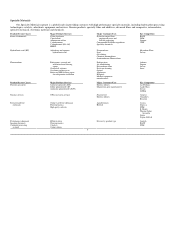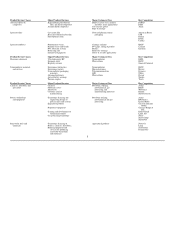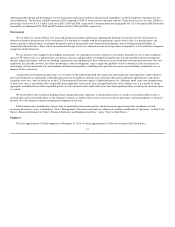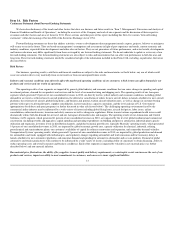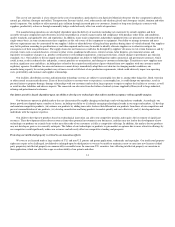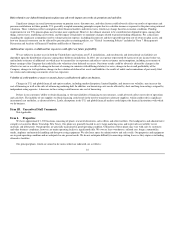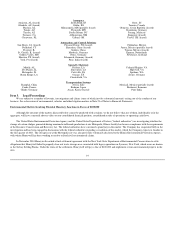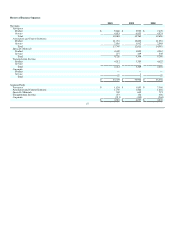Honeywell 2010 Annual Report Download - page 20
Download and view the complete annual report
Please find page 20 of the 2010 Honeywell annual report below. You can navigate through the pages in the report by either clicking on the pages listed below, or by using the keyword search tool below to find specific information within the annual report.
We regularly review our portfolio of businesses and pursue growth through acquisitions and seek to divest non-core businesses. We may not be able to
complete transactions on favorable terms, on a timely basis or at all. In addition, our results of operations and cash flows may be adversely impacted by (i) the
failure of acquired businesses to meet or exceed expected returns, (ii) the discovery of unanticipated issues or liabilities, (iii) the failure to integrate acquired
businesses into Honeywell on schedule and/or to achieve synergies in the planned amount or within the expected timeframe, (iv) the inability to dispose of
non-core assets and businesses on satisfactory terms and conditions and within the expected timeframe, and (v) the degree of protection provided by
indemnities from sellers of acquired companies and the obligations under indemnities provided to purchasers of our divested businesses.
We cannot predict with certainty the outcome of litigation matters, government proceedings and other contingencies and uncertainties.
We are subject to a number of lawsuits, investigations and disputes (some of which involve substantial amounts claimed) arising out of the conduct of
our business, including matters relating to commercial transactions, government contracts, product liability (including asbestos), prior acquisitions and
divestitures, employment, employee benefits plans, intellectual property, import and export matters and environmental, health and safety matters. Resolution
of these matters can be prolonged and costly, and the ultimate results or judgments are uncertain due to the inherent uncertainty in litigation and other
proceedings. Moreover, our potential liabilities are subject to change over time due to new developments, changes in settlement strategy or the impact of
evidentiary requirements, and we may become subject to or be required to pay damage awards or settlements that could have a material adverse effect on our
results of operations, cash flows and financial condition. While we maintain insurance for certain risks, the amount of our insurance coverage may not be
adequate to cover the total amount of all insured claims and liabilities. It also is not possible to obtain insurance to protect against all our operational risks and
liabilities. The incurrence of significant liabilities for which there is no or insufficient insurance coverage could adversely affect our results of operations, cash
flows, liquidity and financial condition.
Our operations and the prior operations of predecessor companies expose us to the risk of material environmental liabilities.
Mainly because of past operations and operations of predecessor companies, we are subject to potentially material liabilities related to the remediation
of environmental hazards and to claims of personal injuries or property damages that may be caused by hazardous substance releases and exposures. We have
incurred remedial response and voluntary clean-up costs for site contamination and are a party to lawsuits and claims associated with environmental and
safety matters, including past production of products containing hazardous substances. Additional lawsuits, claims and costs involving environmental matters
are likely to continue to arise in the future. We are subject to various federal, state, local and foreign government requirements regulating the discharge of
materials into the environment or otherwise relating to the protection of the environment. These laws and regulations can impose substantial fines and
criminal sanctions for violations, and require installation of costly equipment or operational changes to limit emissions and/or decrease the likelihood of
accidental hazardous substance releases. We incur, and expect to continue to incur capital and operating costs to comply with these laws and regulations. In
addition, changes in laws, regulations and enforcement of policies, the discovery of previously unknown contamination or new technology or information
related to individual sites, the establishment of stricter state or federal toxicity standards with respect to certain contaminants, or the imposition of new clean-
up requirements or remedial techniques could require us to incur costs in the future that would have a negative effect on our financial condition or results of
operations.
Our expenses include significant costs related to employee and retiree health benefits.
With approximately 130,000 employees, including approximately 53,000 in the U.S., our expenses relating to employee health and retiree health
benefits are significant. In recent years, we have experienced significant increases in certain of these costs, largely as a result of economic factors beyond our
control, in particular, ongoing increases in health care costs well in excess of the rate of inflation. Continued increasing health-care costs, legislative or
regulatory changes, and volatility in discount rates, as well as changes in other assumptions used to calculate retiree health benefit expenses, may adversely
affect our financial position and results of operations.
17


